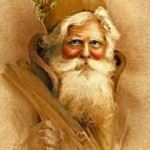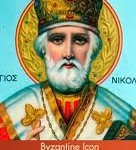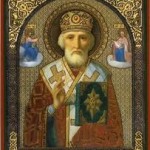

Christmas and The History of Santa Claus

Does Santa Claus Truly Exist In The History of Christmas?
The history of Christmas is closely associated with Santa Claus who is one of the most affectionate legendary and mythical, perhaps historical figures we all have come to love.
Perhaps it was due to his presents on the eve of Christmas on 24 December, or his ‘ho-ho’ laughter or his fatherly figure. He also known as Saint Nicholas, Father Christmas and simply “Santa”.
Who Is The Real Santa Claus?
 How shall we understand or explain the Santa Claus phenomenon and history?
How shall we understand or explain the Santa Claus phenomenon and history?
Is it pure paganism lying to an unsuspecting populace?
Is Santa Claus scriptural? Is he an angle or is he Satan in disguise (there is after all, both names are spelt with the same letters, as some kind souls constantly remind us).
Or is Santa just a symbol of commercialism?
Or is Santa a Christian after all, since he really is St. Nicholas, a Christian bishop of the fourth century? So which is it? Is Santa Claus an angel or hellspawn or something in between? Let’s take a walk through the passage of time to find out how Santa Claus came about, and perhaps we can find some answers.
What’s The Santa Claus History and Story?
Actually, the truth of the matter is that the modern Santa Claus is a mix-mesh of sources, a legendary being that has evolved over the years. Along the way, pre-Christian legends, the story of St. Nicholas, Dutch immigrants to America, Washington Irving, Clement Moore, Thomas Nast, and the Coca-Cola company, all made their contributions.
The Saint Nicholas Connection with Santa Claus History
 It is popularly known that the name “Santa Claus” comes to us by way of the Dutch “Sinter Klaas,” which in turn, was a form of Saint Nicholas. Our modern Santa Claus took his name from the Christian Saint Nicholas so let’s begin with a look at this Christian bishop of the fourth century.
It is popularly known that the name “Santa Claus” comes to us by way of the Dutch “Sinter Klaas,” which in turn, was a form of Saint Nicholas. Our modern Santa Claus took his name from the Christian Saint Nicholas so let’s begin with a look at this Christian bishop of the fourth century.
Throughout history Nicholas of Myra (d. 350) has been one of the most beloved saints even apart from the Santa Claus context. In fact, George McKnight reportedly said that both in the eastern and western Church, Nicholas is “the object of extreme veneration, to a degree unequaled in the case of any other saint.”
Saint Nicholas of Myra was a 4th century Greek Christian bishop of Myra (now Demre) in Lycia, a province of the Byzantine Anatolia, now in Turkey. Saint Nicholas was best remembered for his generous gifts to the poor and needy. There was a story that said he had presented the three impoverished daughters of a pious Christian with dowries thus saving them from becoming prostitutes and slavery. He was very religious from an early age and devoted his life entirely to Christianity and the love of Jesus. He wholeheartedly dedicated his life to serving God and was made Bishop of Myra while still a young man. Bishop Nicholas became known throughout his country for his unconditional generosity to the those in need, his love for children, and his concern for sailors and ships
He is commonly portrayed as a bearded bishop in canonical robes in In continental Europe (more precisely the Netherlands, Belgium, Austria and Germany).
 One early historical record stated that the emperor Justinian built a church in his honor in Constantinople around the year 540. Nicholas is the patron saint of entire nations, including Greece, Russia, Sicily, and Lorraine, and many cities throughout Germany, Austria, Switzerland, Holland, and Italy. He is also patron saint of bakers, children, merchants, and mariners and those who are in poverty.
One early historical record stated that the emperor Justinian built a church in his honor in Constantinople around the year 540. Nicholas is the patron saint of entire nations, including Greece, Russia, Sicily, and Lorraine, and many cities throughout Germany, Austria, Switzerland, Holland, and Italy. He is also patron saint of bakers, children, merchants, and mariners and those who are in poverty.
Unfortunately, very little factual information is actually known about this most popular saint. In the words of Weiser,
there is scarcely any definite historical fact known about him except that he was bishop of Myra in Asia Minor; that he was cast into exile and prison during the persecution of Emperor Diocletian and released by Constantine the Great; that he died in Myra about 350, and in the year 1087 his body was brought by Italian merchants from Myra to the city of Bari in Italy, where his relics are still preserved and venerated in the church of San Nicola.
Is St Nicholas Linked To Paganism?
 Now comes the shocking part for Christians and caring parents : Numerous parallels have been drawn between Santa Claus and the figure of Odin, a major god amongst the Germanic peoples prior to their conversion to Christianity.
Now comes the shocking part for Christians and caring parents : Numerous parallels have been drawn between Santa Claus and the figure of Odin, a major god amongst the Germanic peoples prior to their conversion to Christianity.
There has been many theories suggesting that Germanic peoples, after Christinisation, retained the pagan origins of various customs and elements of their indigenous traditions, surviving and evolving in various forms into modern depictions of Santa Claus.
It is also held by some scholars that the legends of Nicholas as a caring giver drew in part from pagan, preChristian sources. For example, the Teutonic god of the air, Odin, would ride through the air on a gray horse (named Sleipnir) each Autumn – so did Nicholas; Odin had a long whitish beard – so did Saint Nicholas; a sheaf of grain was left in the field for Odin’s horse – children left a wisp of straw in their shoes for Saint Nicholas.
Others claim that attributes of the Germanic god Thor, the god of thunder, were similar to Nicholas. Thor was supposedly elderly and heavy with a long white beard; he road through the air in a chariot drawn by two white goats (called Cracker and Gnasher); he dressed in red; his palace was in the “northland;” he was friendly and cheerful; he would come down the chimney into his element, the fire.
No definitive correlation has ever been established between the “visit of St. Nicholas” and pagan gods such as Odin and Thor. However the similarity is striking and some relationship seems possible.
After the Reformations of the sixteenth century the Feast of St. Nicholas was abolished in many countries. Throughout northern Germany, for example, the Protestants encouraged veneration of the Christkindl (Christ-child) instead, who, it was said, brought gifts to children on Christmas Eve. As an example of this, a Protestant Pastor of the seventeenth century complains about parents who put presents in their children’s beds, telling them that St. Nicholas has brought them. This is a bad custom, he says, “because it points children to the saint, while yet we know that not St. Nicholas but the holy Christ Child gives us all good things for body and soul, and He alone it is whom we ought to call upon.”
Despite this new emphasis, the Nicholas legends prevailed in many places, especially among the Dutch.
Santa Claus in The Millenium
With time, the various versions of Saint Nicholas were merged with also folktales, and story telling of parents who want to give their children suprises by lying that their presents come from fatherly Santa Claus. Santa Claus as we know today is a jolly good fellow, who flies with his reindeer from the North Pole, arrives and climbs through the chimneys, to deliver presents for the kids according to how well behaved they had been.
Dear parents, now that you know the origins and history of Santa Claus, for whatever it is worth, perhaps you should let your children know the source of their true blessings, instead of letting Santa take the credit 🙂
If you like this article, you might also like :
- History of Christmas – Shocking Truths
- Best Christmas Songs of All Time
- Christmas Poems For Kids
- How To Decorate A Christmas Tree
 Leave a Reply
Leave a Reply 









